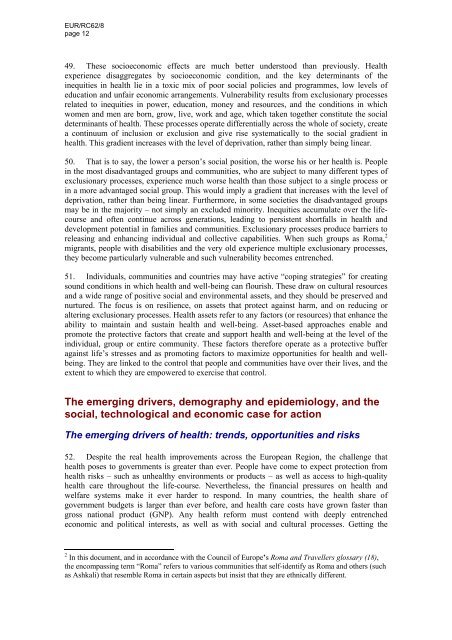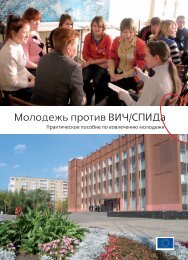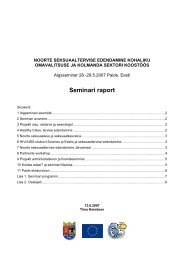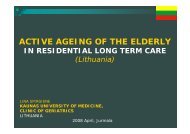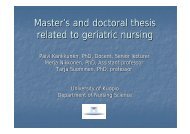EUR/RC62/wd08 (Eng) - WHO/Europe - World Health Organization
EUR/RC62/wd08 (Eng) - WHO/Europe - World Health Organization
EUR/RC62/wd08 (Eng) - WHO/Europe - World Health Organization
You also want an ePaper? Increase the reach of your titles
YUMPU automatically turns print PDFs into web optimized ePapers that Google loves.
<strong>EUR</strong>/<strong>RC62</strong>/8<br />
page 12<br />
49. These socioeconomic effects are much better understood than previously. <strong>Health</strong><br />
experience disaggregates by socioeconomic condition, and the key determinants of the<br />
inequities in health lie in a toxic mix of poor social policies and programmes, low levels of<br />
education and unfair economic arrangements. Vulnerability results from exclusionary processes<br />
related to inequities in power, education, money and resources, and the conditions in which<br />
women and men are born, grow, live, work and age, which taken together constitute the social<br />
determinants of health. These processes operate differentially across the whole of society, create<br />
a continuum of inclusion or exclusion and give rise systematically to the social gradient in<br />
health. This gradient increases with the level of deprivation, rather than simply being linear.<br />
50. That is to say, the lower a person’s social position, the worse his or her health is. People<br />
in the most disadvantaged groups and communities, who are subject to many different types of<br />
exclusionary processes, experience much worse health than those subject to a single process or<br />
in a more advantaged social group. This would imply a gradient that increases with the level of<br />
deprivation, rather than being linear. Furthermore, in some societies the disadvantaged groups<br />
may be in the majority – not simply an excluded minority. Inequities accumulate over the lifecourse<br />
and often continue across generations, leading to persistent shortfalls in health and<br />
development potential in families and communities. Exclusionary processes produce barriers to<br />
releasing and enhancing individual and collective capabilities. When such groups as Roma, 2<br />
migrants, people with disabilities and the very old experience multiple exclusionary processes,<br />
they become particularly vulnerable and such vulnerability becomes entrenched.<br />
51. Individuals, communities and countries may have active “coping strategies” for creating<br />
sound conditions in which health and well-being can flourish. These draw on cultural resources<br />
and a wide range of positive social and environmental assets, and they should be preserved and<br />
nurtured. The focus is on resilience, on assets that protect against harm, and on reducing or<br />
altering exclusionary processes. <strong>Health</strong> assets refer to any factors (or resources) that enhance the<br />
ability to maintain and sustain health and well-being. Asset-based approaches enable and<br />
promote the protective factors that create and support health and well-being at the level of the<br />
individual, group or entire community. These factors therefore operate as a protective buffer<br />
against life’s stresses and as promoting factors to maximize opportunities for health and wellbeing.<br />
They are linked to the control that people and communities have over their lives, and the<br />
extent to which they are empowered to exercise that control.<br />
The emerging drivers, demography and epidemiology, and the<br />
social, technological and economic case for action<br />
The emerging drivers of health: trends, opportunities and risks<br />
52. Despite the real health improvements across the <strong>Europe</strong>an Region, the challenge that<br />
health poses to governments is greater than ever. People have come to expect protection from<br />
health risks – such as unhealthy environments or products – as well as access to high-quality<br />
health care throughout the life-course. Nevertheless, the financial pressures on health and<br />
welfare systems make it ever harder to respond. In many countries, the health share of<br />
government budgets is larger than ever before, and health care costs have grown faster than<br />
gross national product (GNP). Any health reform must contend with deeply entrenched<br />
economic and political interests, as well as with social and cultural processes. Getting the<br />
2 In this document, and in accordance with the Council of <strong>Europe</strong>’s Roma and Travellers glossary (18),<br />
the encompassing term “Roma” refers to various communities that self-identify as Roma and others (such<br />
as Ashkali) that resemble Roma in certain aspects but insist that they are ethnically different.


